For non-pilots who usually fly in airliners and rate a flight based on the landing more than any other criteria, and who judge the quality of the landing by the touchdown, let me expand your knowledge of this most important pilot task by pointing out that when the wheels meet the concrete it ain’t over yet.
The reason is that the airliner has just become the fastest tricycle in the West, and the potential for mayhem still exists in the form of inertia: a property of matter by which it continues in its existing state of rest or uniform motion in a straight line. Some of you may remember the formula: inertia equals mass times velocity squared. What this means is that something really heavy (like an airliner) going fast (well over 100 mph) has bunches of inertia waiting to cause the pilot a real headache if something goes wrong.
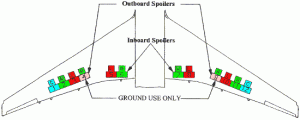 To avoid inertia-related problems, the pilot needs to reduce it. Since lowering gross weight at that moment is not possible, slowing up is the only option, and modern airliners offer the pilot three ways to do that: brakes, spoilers, and thrust reversers.
To avoid inertia-related problems, the pilot needs to reduce it. Since lowering gross weight at that moment is not possible, slowing up is the only option, and modern airliners offer the pilot three ways to do that: brakes, spoilers, and thrust reversers.  Spoilers are panels built into the top of the wing (shown in color on the diagram of the Boeing 757 upper wing surface) that can be raised into the slipstream to create drag. Thrust reversers deflect a portion of engine exhaust forward. (The dark ring at the rear of the Boeing 777’s engine pictured on the right is a deployed reverser) Both are very effective at shedding airspeed, especially early in the landing roll when speed is highest.
Spoilers are panels built into the top of the wing (shown in color on the diagram of the Boeing 757 upper wing surface) that can be raised into the slipstream to create drag. Thrust reversers deflect a portion of engine exhaust forward. (The dark ring at the rear of the Boeing 777’s engine pictured on the right is a deployed reverser) Both are very effective at shedding airspeed, especially early in the landing roll when speed is highest.
At touchdown speeds, brakes are the least effective of the three, which leads to an interesting safety measure when figuring landing data: all landings are planned without considering the beneficlal effects of spoilers and thrust reversers. It’s as if they are “extra.” Although you normally use them, you never count on them.
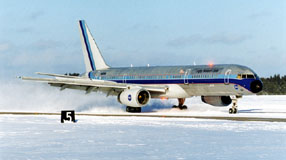 Runways “contaminated” with water, slush, snow, or ice complicate the landing problem because the brakes aren’t very effective for slowing the airplane if the tires aren’t in solid contact with the runway. Although the pilot still can’t plan to use them, spoilers and thrust reversers are much more valuable when landing in these conditions because they don’t rely on friction. In case you figured this explanation was leading up to something, you were right. The following borrows heavily from AVweb.
Runways “contaminated” with water, slush, snow, or ice complicate the landing problem because the brakes aren’t very effective for slowing the airplane if the tires aren’t in solid contact with the runway. Although the pilot still can’t plan to use them, spoilers and thrust reversers are much more valuable when landing in these conditions because they don’t rely on friction. In case you figured this explanation was leading up to something, you were right. The following borrows heavily from AVweb.
 On December 29, 2010, an American Airlines Boeing 757 ran off the end of Runway 19 in snowy conditions while landing at Jackson Hole Airport. About seven inches of snow had fallen in the area since midnight, but the runway itself had good braking coefficients (a measure of braking effectiveness, which means that the pilots had no reason to suspect that runway conditions were not suitable for landing). No injuries were reported among the 181 passengers and crew on board.
On December 29, 2010, an American Airlines Boeing 757 ran off the end of Runway 19 in snowy conditions while landing at Jackson Hole Airport. About seven inches of snow had fallen in the area since midnight, but the runway itself had good braking coefficients (a measure of braking effectiveness, which means that the pilots had no reason to suspect that runway conditions were not suitable for landing). No injuries were reported among the 181 passengers and crew on board.
The incident was partially recorded on video by a passenger and posted on YouTube. The video, taken out of a window, shows a portion of the wing upper surface and the top of an engine and has led to a fair amount of speculation by some pilots.
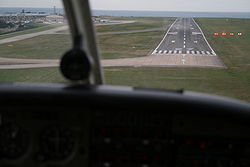 The aircraft appears to be on the ground prior to passing the wind sock and PAPI lights (visual glide path indicators, the four lights located near the approach end of the runway), which indicates the pilot touched down at an appropriate point and did not “land long.” In the video, the engine’s thrust reverser panel first moves just after touchdown, but it does not fully open and the outboard spoilers are not visibly deployed. Because of that, things quickly get more interesting.
The aircraft appears to be on the ground prior to passing the wind sock and PAPI lights (visual glide path indicators, the four lights located near the approach end of the runway), which indicates the pilot touched down at an appropriate point and did not “land long.” In the video, the engine’s thrust reverser panel first moves just after touchdown, but it does not fully open and the outboard spoilers are not visibly deployed. Because of that, things quickly get more interesting.
A full ten seconds after touchdown, the thrust reverser panel moves from barely open to closed, and does not begin to reopen, this time fully, until approximately seven seconds later (17 seconds after touchdown). The engines do not appear to spool up (to increase the amount of reverse thrust) until roughly ten seconds later. From this we can conclude that the 757 rolls on the runway for 27 seconds before the reversers appear amply engaged. This is way too late to be of much use, and the aircraft departs the end of the runway roughly nine seconds later. That moment is very obvious on the video.
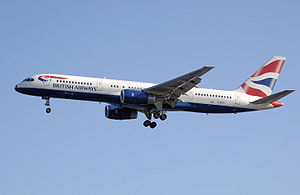 Pilots who claim to be familiar with the 757 have left comments in professional pilot forums stating that the thrust reversers on the 757 can sometimes refuse to engage. Others have speculated that a problem with the hydraulics or Boeing’s air/ground logic system (which, in plain language, “tells” the aircraft whether it’s on the ground or in the air) could have prevented the spoilers, reversers, and the brakes from working properly.
Pilots who claim to be familiar with the 757 have left comments in professional pilot forums stating that the thrust reversers on the 757 can sometimes refuse to engage. Others have speculated that a problem with the hydraulics or Boeing’s air/ground logic system (which, in plain language, “tells” the aircraft whether it’s on the ground or in the air) could have prevented the spoilers, reversers, and the brakes from working properly.
Subsequent events have focused a spotlight on the actions of American Airlines immediately following the incident.
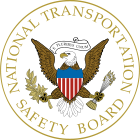 According to the National Transportation Safety Board (NTSB), airline technicians violated standard procedures when they removed the cockpit voice recorder and the digital flight data recorder (DFDR) and flew them to Tulsa, Okla., where technicians downloaded information from the DFDR. It is common in incident investigations for the airline involved to transport the recorders on their own aircraft, to get them to NTSB labs in Washington. D.C., as quickly as possible. The airline is instructed to transport the recorders without delay and without accessing the information contained within them by any means.
According to the National Transportation Safety Board (NTSB), airline technicians violated standard procedures when they removed the cockpit voice recorder and the digital flight data recorder (DFDR) and flew them to Tulsa, Okla., where technicians downloaded information from the DFDR. It is common in incident investigations for the airline involved to transport the recorders on their own aircraft, to get them to NTSB labs in Washington. D.C., as quickly as possible. The airline is instructed to transport the recorders without delay and without accessing the information contained within them by any means.
 NTSB: “Although a thorough examination by our investigators determined that no information from the DFDR was missing or altered in any way, the breach of protocol by American Airlines personnel violates the Safety Board’s standards of conduct for any organization granted party status in an NTSB investigation. We have revoked the party status of American Airlines and excused them from further participation in this incident investigation.” (Note: “party status” is a term used by the NTSB to designate outside organizations that will be allowed to play a role during an investigation. American Airlines, Boeing Aircraft, and Pratt & Whitney — the engine manufacturer — would all be given party status as a normal procedure.)
NTSB: “Although a thorough examination by our investigators determined that no information from the DFDR was missing or altered in any way, the breach of protocol by American Airlines personnel violates the Safety Board’s standards of conduct for any organization granted party status in an NTSB investigation. We have revoked the party status of American Airlines and excused them from further participation in this incident investigation.” (Note: “party status” is a term used by the NTSB to designate outside organizations that will be allowed to play a role during an investigation. American Airlines, Boeing Aircraft, and Pratt & Whitney — the engine manufacturer — would all be given party status as a normal procedure.)
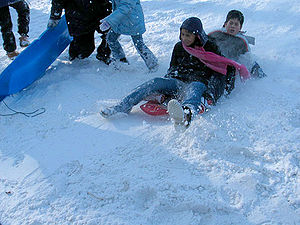 There will be more to come as the NTSB conducts its investigation. In the meantime, I’ll do a bit of speculating on my own: if no mechanical malfunction is discovered, this incident will be labeled as a result of pilot error. When you touch down on a runway that might be contaminated with snow, slush, and/or ice, it’s imperative that you recognize the potential mayhem that awaits the fastest sled in the West and actively plan to avoid it.
There will be more to come as the NTSB conducts its investigation. In the meantime, I’ll do a bit of speculating on my own: if no mechanical malfunction is discovered, this incident will be labeled as a result of pilot error. When you touch down on a runway that might be contaminated with snow, slush, and/or ice, it’s imperative that you recognize the potential mayhem that awaits the fastest sled in the West and actively plan to avoid it.
At main gear touchdown, check throttles at idle, lower the nose gear to the runway, deploy the thrust reversers, confirm that the automatic system has deployed the spoilers, and increase reverse thrust (to the maximum if necessary) to slow the aircraft as rapidly as 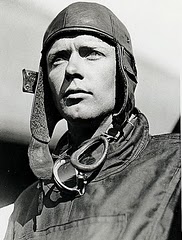 possible. Depending on the runway condition, test the brakes by applying them as well and be alert for anti-skid cycling, which indicates the wheels are in contact with the runway, and any tendency of the aircraft to veer off of runway heading.
possible. Depending on the runway condition, test the brakes by applying them as well and be alert for anti-skid cycling, which indicates the wheels are in contact with the runway, and any tendency of the aircraft to veer off of runway heading.
Then the passengers will deplane (at the gate, not into a snow-covered field) with admiration in their eyes and nods of appreciation to you, the steely-eyed aviator, for the magnificent display of cockpit prowess they just witnessed.
(Please forgive me for that last paragraph, but I just couldn’t help myself.)


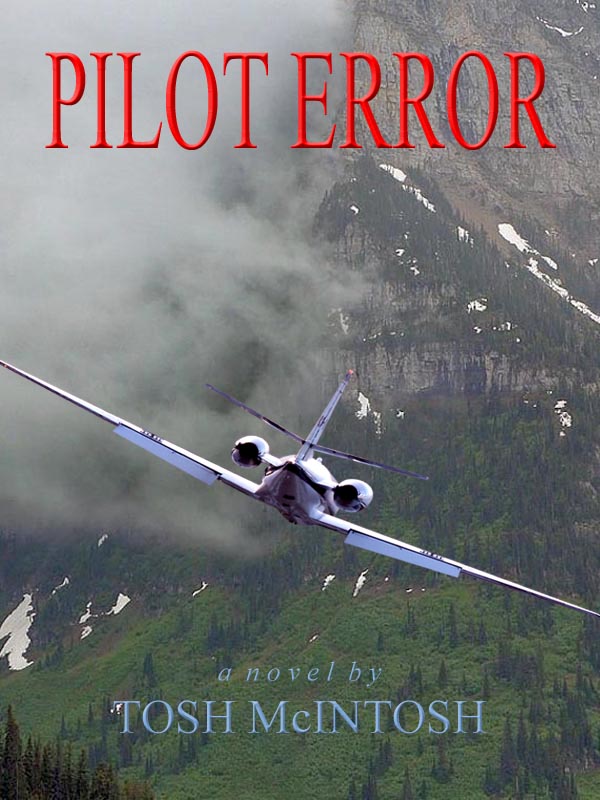
One Response to Fastest Tricycle in the West